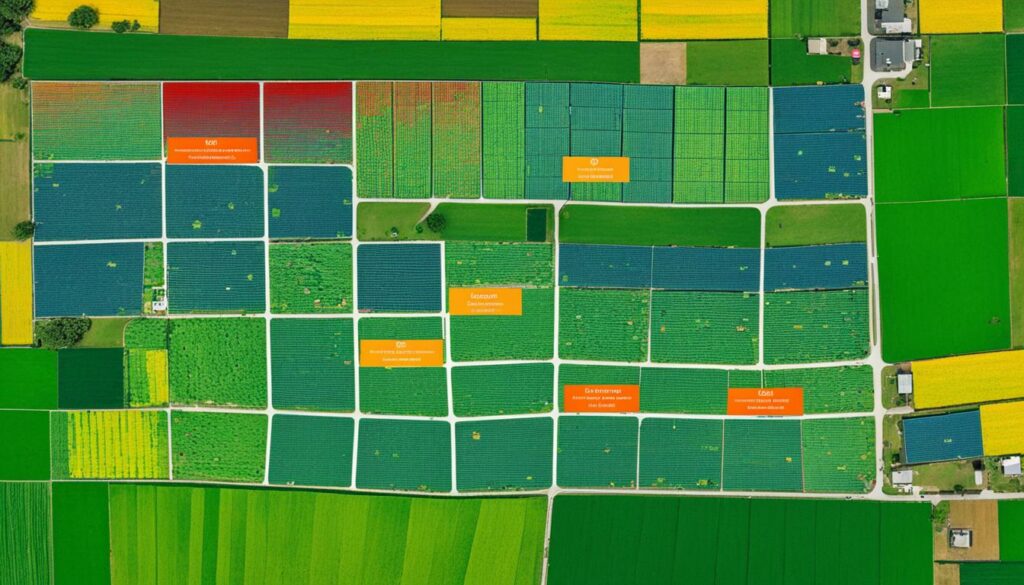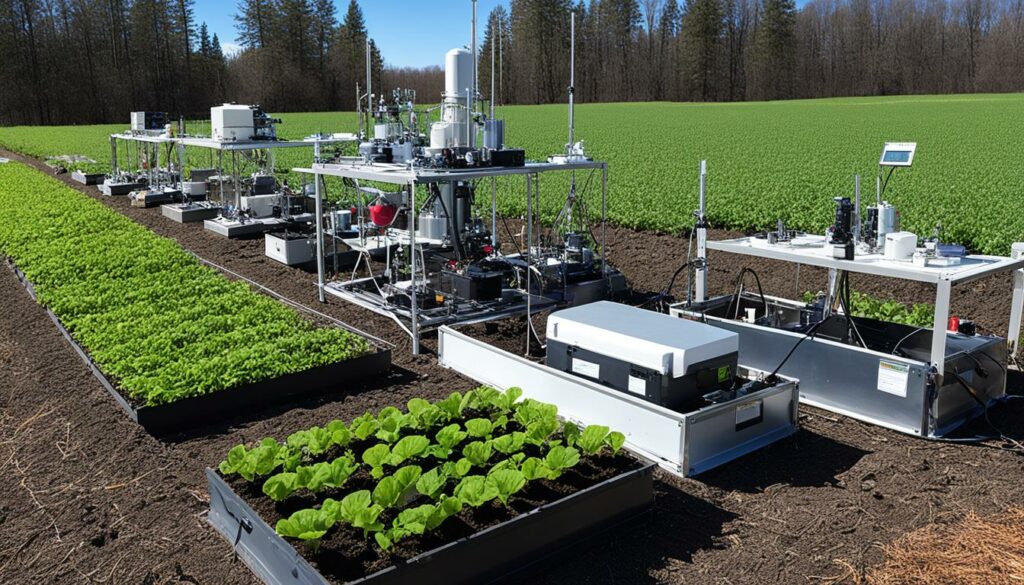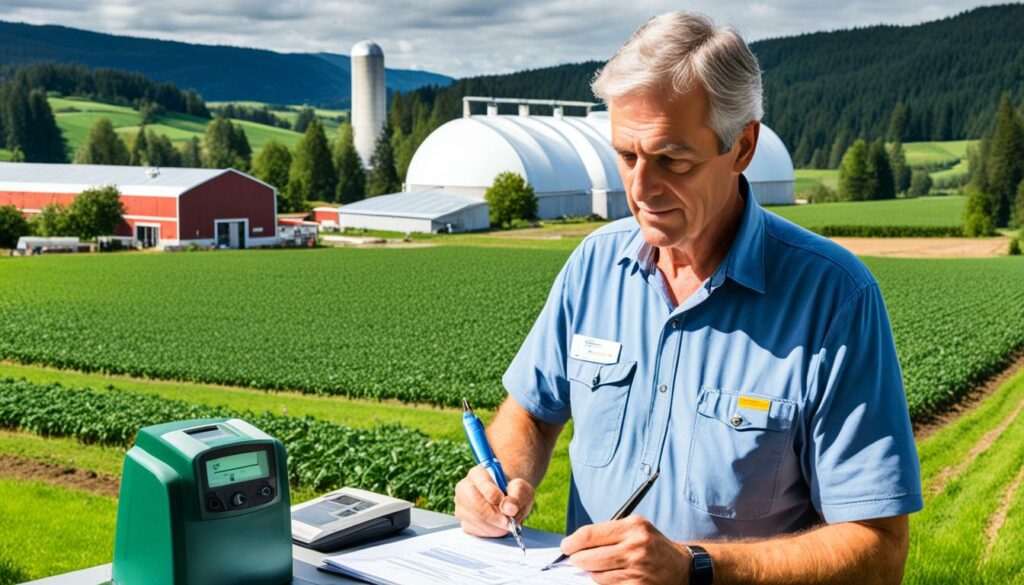Menu

Did you know farming helps keep our air clean? It’s true! There’s nearly three times more carbon in the ground than in our air. This shows why keeping track of farms’ carbon footprints is so important for our planet’s health.
The USDA’s Greenhouse Gas Inventory Programme is key here. It works with other agencies to measure greenhouse gases from farms and forests. This helps us know if we’re doing enough to fight climate change.
Knowing how much carbon goes in and out of the ground is crucial. It helps farmers make smart choices and grab new market chances.
The USDA publishes reports on greenhouse gases from farming and forestry. They show emission levels and how farms can soak up carbon. This data stretches from 1990 to 2018, covering emissions from every U.S. state and region.
Farms are now looking closely at their carbon footprints. This is important as it helps them see and lower their impact on the environment. With the right tools, farmers can figure out how much greenhouse gas their work releases.
Carbon footprint reports are key for farmers and for everyone. They show how well farm practices help the environment. They also point out where farms can do better. By working on their carbon footprint, farms help fight climate change. But to make a real difference, the data must be spot on.
Farms can give off a lot of greenhouse gases. In the UK, most of the nitrous oxide and nearly half of the methane comes from farming. Although emissions dropped by 16% over the past 30 years, farming still has a big impact on the climate.
“In 1996, emissions intensity from cattle saw a spike due to the ‘over thirty months rule’ following the BSE outbreak. Nonetheless, since 1990, the emissions intensity from cattle and other livestock categories, like dairy and pigs, has experienced a reduction.”
Farms can do their part by using eco-friendly methods. The goal is to balance out emissions with ways to trap carbon. Achieving net-zero greenhouse gas emissions is the aim. Good farm reports help choose the best ways to protect the environment.
The USDA is key in tracking greenhouse gas outputs. They analyse emissions from farming and forestry over the years. This study helps include new eco-friendly methods and checks the data’s accuracy.
The USDA’s program, under the Office of the Chief Economist, watches emissions from farms. Since 1990, they’ve collected a lot of data on gases and farming practices. This work is essential in fighting climate change by giving the best facts for decisions.

Using the best methods to measure a farm’s carbon footprint is crucial. Reports like “Quantifying Greenhouse Gas Fluxes in Agriculture and Forestry” give farmers strong ways to check their impact. These let farmers look closely at their greenhouse gas levels. This means they can use smarter, more effective farming techniques.
Making reports on time is a big part of what the USDA does. For example, the “Marginal Abatement Cost Curves” shows farming’s carbon-cutting costs. They help in managing emissions and making farming more green. Also, the “Federal Strategy for Advancing Greenhouse Gas Monitoring” shows the USDA’s push for better data. This improves the support they can give to farmers for greener practices.
Assessing the environmental impact on farms is crucial for their sustainability. Various tools aid farmers in measuring and reducing their carbon footprints.
COMET-Farm is an online tool made for carbon footprint reporting in farming and ranching. It walks users through their farm management, showing current and possible future scenarios. This tool gives detailed reports on carbon and greenhouse gas changes. It helps users see how different practices affect their carbon footprint.
Using COMET-Farm is simple. Users enter their farm’s details, like how they manage land and the types of soil. Then, it shows how much greenhouse gases and carbon they might emit in the future. The end result is a report that helps farmers choose ways to lower their environmental impact. COMET-Farm is known for being practical and offering good user help, unlike many carbon footprint tools.
Besides COMET-Farm, there are other helpful tools for farms to report their carbon use. The USDA’s Greenhouse Gas Inventory and Assessment Program plays a key role. It offers methods and tools that make it easier to check on greenhouse gas and carbon sequestration in farming and forests. This program works with different groups to gather data accurately.
Moreover, the USDA gives out Marginal Abatement Cost Curves. These curves help figure out the costs and benefits of eco-friendly technologies and practices in the U.S. They’re crucial for farmers looking into climate-smart agriculture. This underlines the importance of having tools for in-depth carbon footprint reports.
The USDA is working hard to check on our environment and make farming better. Their latest report, named “Quantifying Greenhouse Gas Fluxes in Agriculture and Forestry: Methods for Entity-Scale Inventory,” shows this. It’s an update from 2014, aiming to make checking on greenhouse gases more accurate and easier. They did this by working with many others to review the methods together.

Farming and taking care of forests are key to keeping our planet healthy. The USDA has worked with Colorado State University and others to create methods for farmers to measure their greenhouse gases. These methods are easy to use, making it simpler for people to know their impact. They focus on single farms or forest areas, offering clear steps and tools for a better check on gas emissions.
The 2024 edition of the report is really detailed, thanks to the efforts of over 60 authors and feedback from many experts. The USDA is known for its accurate reports on greenhouse gases, making their advice trustworthy. They made sure the methods in this report are not hard to use. This helps people put in place eco-friendly farming and see how they are helping the environment. The USDA is all about supporting efforts to care for the land and use smart farming to fight climate change in the US.
Here is a detailed comparison of updates highlighted in the 2024 report:
| Aspect | 2014 Report | 2024 Report |
|---|---|---|
| Number of Authors | Various contributors | Over 60 authors |
| Review Process | Limited reviews | More than two dozen scientists, public, interdisciplinary experts |
| Tools and Guidance | Initial guidance provided | Enhanced tools for farmers, ranchers, forest landowners |
| Collaboration | Inter-agency collaboration | Collaboration with NGOs, universities, research institutions |
The USDA is encouraging farms to be more environmentally friendly. They are doing this by promoting strategies. These include sustainable farming practices and methods to store carbon. This helps reduce harmful emissions.
Conservation is key in efforts to fight climate change. The USDA supports actions like conserving the soil, better handling of manure, and adding biochar to soil. These efforts improve the earth and cut down on gases that harm our atmosphere.
Research shows these methods are cost-effective and bring many benefits. They not only help the environment but also make farms more efficient. This way, farmers play a big role in fighting climate change and keep their businesses healthy.
The USDA is helping farmers earn rewards for saving the environment. They support actions that trap carbon. By using special ways to measure their impact, farmers can join in markets that value a clean environment.
This approach is supported by national strategies for accurate information. It helps make markets that support green farming. These actions are vital for the future of our food, our planet, and our farmers.
Keeping up with federal rules on measuring greenhouse gases is key for a green agriculture. Through the USDA’s works, we continually improve how we check environmental effects. The USDA follows a plan called the “Federal Strategy for Advancing Greenhouse Gas Monitoring and Measurement.” This plan guides farmers to report their greenhouse gases in a clear and uniform way.
The USDA has laid down a detailed plan to watch and report greenhouse gases. This plan was updated in 2024, after four years of work by over 60 experts. Thanks to this effort, we have the best ways to understand and measure the environmental impact of farming. These methods ensure we correctly look into and report gases from fields, forests, and more.

Getting the public involved is crucial in measuring greenhouse gases. The USDA welcomes everyone to comment on its procedures. This approach makes sure everyone has a say and cares about our planet. It involves farmers, researchers, and green groups working together. The USDA’s work is stronger and more reliable due to this shared effort.
| Statistic | Details |
|---|---|
| Updated Report | Second edition, published in 2024 |
| Authors and Experts | More than 60 authors from USDA, universities, and NGOs |
| Years of Development | Four years |
| US Net Agricultural Emissions | Roughly 10% of GHG emissions |
| Goal by 2030 | 50 to 52% reduction in GHG emissions from 2005 levels |
The USDA’s way of including the public and using solid science points to success in measuring greenhouse gases. This focus on working together gives true and clear insights on the environmental impact. It also pushes farming towards meeting climate aims. The goal is to have no extra emissions by 2050.
We need to understand how cutting greenhouse gases affects the economy. The Earth’s average temperature has gone up by 1.8°F in 115 years. It’s key to see if eco-friendly farming can be cost-effective and make the market grow.
The USDA helps farmers by figuring out the costs of going green. They look at how different methods can lower emissions. For example, using less fertiliser can reduce nitrous oxide a lot.
Also, planting cover crops and disturbing soil less helps with carbon dioxide too.
Going green also creates new chances to sell farm goods. There will be more need for crops that can handle stress. This is good news for those who farm using sustainable ways.
Looking at California, there’s lots of demand for biogas because of strict greenhouse gas rules. This pushes up prices for eco-friendly fuel. Plus, farmers earn extra money thanks to these rules.
Green practices not only help the planet but also boost farmers’ incomes. The US government and some companies offer cash to help farmers. They support their move to cleaner practices.
| Mitigation Practice | Emission Reduction | Cost Implications |
|---|---|---|
| Targeted Fertiliser Application | Reduces Nitrous Oxide | Moderate Implementation Costs |
| Drought-Tolerant Crops | Mitigates Yield Risks | Higher Initial Investment, Long-term Savings |
| Cover Crops | Lowers CO2 Emissions | Low to Moderate Costs |
| Biogas Production | Reduces Methane Emissions | High Capital Costs, Variable Returns |
So, studying how cutting gases impacts the economy is very important. By looking at the costs and chances to sell more, farmers can help the planet and their wallets too.
Knowing how to report on carbon footprints is key for farms that want to be greener. The Greenhouse Gas Protocol helps them keep track of emissions. This makes sure reports are accurate.
The Greenhouse Gas Protocol sorts emissions into two groups. Scope 1 emissions come straight from farm activities, like using machinery. Scope 2 emissions, on the other hand, are from buying and using electricity. This sorting helps farms report their carbon footprints right.
Farms need to use the same measurements when they work out their emissions. They usually measure in tonnes of carbon dioxide equivalent (CO2e). This makes it easier to compare with other farms. For example, Coton Wood farm’s carbon balance is 4,803.79 tonnes CO2e a year.

Figuring out emission factors is hugely important for farm reports. Emission factors show how much each activity adds to emissions. At Coton Wood, for example, emissions from livestock are 80.31%. This info helps farms focus on where they can cut emissions the most.
| Emission Source | Percentage of Total Emissions |
|---|---|
| Livestock | 80.31% |
| Fuels | 6.07% |
| Crops | 5.03% |
As the farming world changes, knowing how indoor farming affects the environment is key. This study looks into how much energy indoor farming uses and the value of checking its carbon footprint. It shows why the farming industry should do careful evaluations of its impact.
Indoor farms are working hard to use energy better for the environment. They look at their carbon footprint each year to find where they waste energy. Fixing these energy wasters can save a lot of money.
To figure out the carbon footprint, farms look at how often they use their machinery and their energy bills for a year. They then see how much greenhouse gases they release. This helps them understand how to be more eco-friendly.
When assessing their carbon footprint, indoor farms put emissions into three groups: Scope 1, Scope 2, and Scope 3. This organisation helps them see where the emissions come from. Depending on the source, emissions are looked at as either direct, like from the machines, or as more distant, such as from the energy supplier or general farm suppliers.
In doing these checks, they follow guides like The Greenhouse Gas Protocol. These guides help farms do accurate calculations of their emissions. They calculate greenhouse gases like Carbon Dioxide and Methane to get precise results.
The findings are then shared, usually in the weight of emissions and based on different areas. This helps farms see big patterns in their emissions. It shows them where they’re using too much energy, helping them become more efficient. This efficiency boost is good for the planet and for saving money.
Engaging in carbon footprint reporting helps farms in many ways. It goes beyond helping the environment. This approach benefits farms by making them more sustainable. It also helps in better managing resources. And it makes their operations more efficient, leading to cost savings.
Carbon footprint reporting has big advantages for farms. It improves the way they manage their resources. By using data from the USDA’s Greenhouse Gas Inventory, farmers can start using climate-friendly techniques. This means they can track and reduce greenhouse gas emissions. And this leads to better resource management. Knowing their carbon footprint helps farmers choose greener practices, cutting their harm to the environment.
One key benefit is the boost to operational efficiency on farms. By reporting on their carbon footprints, farms can spot and fix inefficiencies. Especially in how they use utilities. They can then set goals to use less, saving money. The USDA and tools like COMET-Farm help by giving reports and advice. This can cut the need for extra heating and improve how they use energy. It’s a win for the planet and their pocket.

Summing up, the benefits of carbon footprint reporting are vast. Time to integrate cutting-edge data collection and tools is rewarding. It means more sustainable practices, better resource use, and big savings. All leading to a greener, more efficient agriculture industry.
Sustainable farming still has a long way to go. One big issue is creating accurate carbon footprint reports. This is because getting the right data, breaking tech barriers, and dealing with money problems are tough. Making a trustworthy report that fits the real world is hard work.
Getting the data right is hard because farms are so different. A report’s accuracy relies on this data. But, when farms vary in their sizes, what they grow, and how they operate, it’s a challenge.
For instance, in the U.S., many farms use eco-friendly ways to till the land. But, keeping track of these practices across the nation is tough. Also, not many farms use cover crops, which makes uniform data collection even harder.
Technology makes reporting on carbon footprints complex too. Tools like the USDA’s COMET-Planner can help, but farmers need to use them easily. And fancy tools, like drones checking nitrogen levels, can help a lot but need big tech setups.
Making reports can cost a lot too. The U.S. spent almost $20 billion in five years on conservation. Still, small or less advantaged farmers struggle to afford the needed tech or tools. A recent $300 million investment aims to help by supporting programs that assist farmers.
Solving these issues takes teamwork. This means better data methods and support for farmers. Together, we can improve carbon footprint reporting in farming.
The future of farming is changing due to a focus on being kind to the environment. We’re seeing more sustainable and green farming methods. These approaches are in line with the growing global interest in staying healthy and taking care of the planet. This has led to a higher demand for food that’s grown in ways that don’t harm the environment.

New tech and ways of doing things are making big changes in farming. There are cool apps that help share food, and high-tech treatments after harvesting, like FruitMag™ by ICL. These are helping to cut down on the 8 to 10 percent of the world’s human-made emissions that come from throwing away food.
Eating more plant-based or lab-grown protein foods is also becoming popular. This move is good for our health, for the planet, and for being fair to animals. If more people switch from eating meat, we could save an area as big as 640 million hectares of land. This shows just how important these green farming trends are.
It’s critical that governments support eco-friendly farming. They are offering money, like green bonuses and support schemes. These help farmers switch to greener ways of farming. Such support helps lower harmful emissions and introduces new ways for farmers to get support and finance.
There’s a lot of agricultural land in the world, about 4.9 billion hectares. This makes up 38 percent of the world’s dry land. If we use farming methods that help nature and heal the land, we could cut many emissions. By 2050, we could reduce up to 6.7 GtCO2e. This shows how working with nature and good policies can shape the future of farming.
Sustainable farming and its connection to our environment are clear through much research. We looked at studies from Australia, Europe, and China. They show farming affects the planet differently. This tells us why it’s important to measure agriculture’s effect on the environment well. For example, dairy farming in Australia creates 57 to 70 units of carbon. Yet, farming on the Loess Plateau in China makes 525 to 536 kg of CO2 for each hectare.
Sustainable farming does a lot to fight climate change and keep our soil healthy. By changing how we use the land, we can change how much carbon the soil stores. The best part is that farms can be designed to keep more carbon, especially by using wetlands. They can trap a lot of carbon, which is good for our planet.
Using tools like COMET-Farm can help us measure our farm’s carbon use better. We also need to work on managing waste and changing soil use. This can cut down our farm’s carbon use a lot. It’s very important that agriculture keeps getting better. Doing so can help us have enough food and protect our planet’s future.
Carbon footprint reporting is key for tracking and lowering farming’s impact on the environment. It offers insight into the amount of greenhouse gases produced. This shows the value of using sustainable methods in farming.
Farms add to greenhouse gas emissions through activities like livestock feeding and using fertilisers. It’s essential to track these emissions to find ways to farm in an eco-friendly manner.
The USDA leads in monitoring agricultural and forestry greenhouse gas emissions. It works with other groups to encourage farming that’s good for the climate. This means they help set up ways to measure and report these emissions accurately.
COMET-Farm is an important tool for farmers to check their greenhouse gas levels. It allows them to see the effects of their current farming practices. They can also test out new practices to see how they might reduce emissions.
The USDA provides detailed ways to measure greenhouse gas emissions. Their methods are designed to be precise and easy to use. This makes monitoring emissions better and more effective for everyone.
Farms can join carbon offset schemes by using eco-friendly farming practices. For example, tilling the land less, managing manure well, and adding biochar to the soil. These methods help take carbon out of the air and cut overall emissions.
Following guidelines like the “Federal Strategy for Advancing Greenhouse Gas Monitoring and Measurement” is important for farms. It involves how to measure and report emissions correctly. Also, it means having a say in how sustainable farming is shaped.
Economic factors look into the costs of reducing emissions and how these efforts can help in the market. This knowledge helps farmers to make smart choices for their business. It encourages them to grow products in a way that’s good for the climate.
The Greenhouse Gas Protocol divides emissions into direct and indirect. This makes it easier for farms to track their emissions correctly. Following these standards helps farms understand their impact on the environment better.
In indoor farming, the way energy is used and its environmental effects are crucial. Analysing carbon footprints shows where energy is wasted. This leads to making indoor farming methods more planet-friendly.
Reporting on carbon footprints has lots of pluses. It boosts how sustainable a farm is, improves how they use resources, and their effectiveness. It also helps them save money by spotting and fixing inefficient practices.
Getting the right data, dealing with tech problems, and the costs can be tough. Solving these issues makes emission reports more trustworthy and helpful. It benefits all kinds of farms.
In the future, we’ll see more farming methods that are good for the earth. There’ll be new ways of farming that are kind to the environment and supportive policies. These changes will lead to farming that’s greener and more productive.